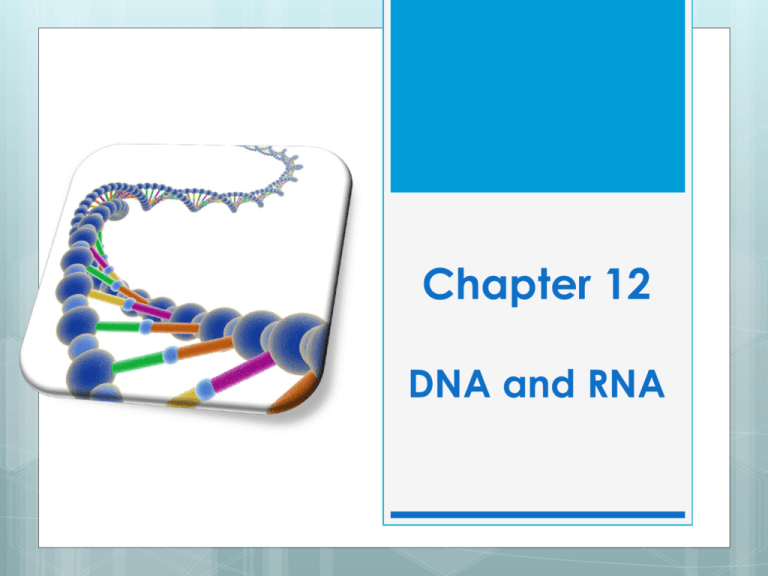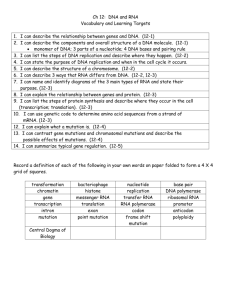File
advertisement

Chapter 12 DNA and RNA 12-1 Chapter 12-1: DNA Objectives: •Explain the relationship between genes and DNA •Describe the structure of DNA 12-1 Structure of DNA DNA = deoxyribonucleic acid DNA is a nucleic acid polymer of nucleotides Nucleotides are made up of a Deoxyribose sugar Phosphate group Nitrogenous base Nitrogenous base Nucleotide Phosphate group Deoxyribose 12-1 Structure of DNA 4 nitrogenous bases Purines A Pyrimidines G C 2 purines T Adenine Guanine 2 pyrimidines Cytosine Thymine Purines have two rings in their structure, pyrimidines have one Phosphate group Deoxyribose 12-1 Structure of DNA Nucleotide DNA is has two strands arranged in a double helix “twisted ladder” Sugar-phosphate Sugar-phosphate backbone backbone Nitrogenous bases are the rungs of the ladder Strands are held together by hydrogen bonds Hydrogen bonds 12-1 Base Pairing Guanine Cytosine G-C Adenine thymine always bonds to always bonds to A-T Note that each purine has a complimentary pyrimidine If the sequence of one strand was AAGCTTCGA what would the complimentary be? 12-2 Chapter 12-2: Chromosomes and DNA Replication Objectives: • Link DNA and chromosomes • Explain the process of DNA replication 12-2 Chromosome Structure DNA must be tightly coiled and compressed in order to fit in a cell A cell’s DNA is ~600,000 times longer than the cell itself! Chromosomes of chromatin are made up DNA and proteins called histones Nucleosomes are spooled units of DNA wrapped around histones 12-2 Chromosome Nucleosome DNA double helix Coils Supercoils Histones 12-2 Eukaryotic vs. Prokaryotic Chromosomes Prokaryotes have a single chromosome Eukaryotes have multiple chromosomes ~1000x more DNA than prokaryotes 12-2 DNA Replication Before a cell divides its DNA must be copied in a process called replication Ensures that each cell has a complete set of DNA Based on complementary base pairing The double helix is separated and each strand becomes the template for a new double helix 12-2 DNA Replication Step 1 The DNA strand is unzipped by the enzyme DNA helicase Hydrogen bonds are broken DNA Replication Step 2 The 12-2 enzyme DNA polymerase adds complementary nucleotides to the exposed strands 12-2 DNA Replication Summary 12-3 Chapter 12-3: RNA and Protein Synthesis Objectives: • Compare/contrast RNA and DNA • Describe the 3 types of RNA • Explain the process of transcription • Explain how RNA is used to make proteins 12-3 RNA Ribonucleic acid Nucleotide polymer Single-stranded Ribose sugar instead of deoxyribose Nitrogenous bases include: Adenine Guanine Cytosine Uracil Usually much shorter Disposable 12-3 Types of RNA 3 types All used during protein sythesis 1. Messenger RNA (mRNA) 2. Ribosomal RNA (rRNA) 3. Carries information for making proteins from DNA to ribosomes Makes up ribosomes (along with various proteins) Transfer RNA (tRNA) Brings amino acids to the ribosome as specified by mRNA 12-3 Transcription mRNA is made from a segment of DNA Steps for RNA polymerase: 1. Binds to DNA at a promoter site 2. Separates DNA strands 3. Uses one DNA strand as a template to make a strand of mRNA 4. Stop signal is reached 12-3 Transcription Adenine (DNA and RNA) Cystosine (DNA and RNA) Guanine(DNA and RNA) Thymine (DNA only) Uracil (RNA only) 12-3 RNA Processing Not all information from DNA is necessary mRNA must be “edited” before protein synthesis Occurs in nucleus Introns are useless sequences that are removed Exons are the remaining segments that actually code for proteins Spliced together after introns are removed 12-3 The Genetic Code Polypeptides are long chains (polymers) of amino acids Called proteins when very long or in their final stable form There are 20 amino acids but only 4 nitrogenous bases Codons are 3 nucleotide sequences that code for specific amino acids 12-3 The Genetic Code Start Alanine - Threonine - Glutamic acid - Leucine - Arginine - Serine - STOP 12-3 Translation 12-3 Translation 12-4 Chapter 12-4: Mutations Objectives: • Explain the difference between gene mutations and chromosomal mutations • Evaluate the severity of various genetic mutations Mutations Gene Mutations Chromosomal Mutations Point Mutations Substitutions Deletion Frameshift Mutations Duplication Inversion Insertions Deletions Tanslocation 12-4 Gene Mutations Small DNA changes One or a few nucleotides Point mutations occur at a single point in the DNA sequence 3 Types of point mutations: Substitutions Deletions Insertions 12-4 Substitution Mutations One nitrogenous base is changed to another Usually affects only one amino acid Least harmful mutation Substitution 12-4 Frameshift Mutations Caused by either a deletion or an insertion Entire “reading frame” is shifted Multiple amino acids affected Deletion 12-4 Chromosomal Mutations Changes in the number or structure of entire chromosomes Impacts much more genetic information than gene mutations 4 Much more severe Types: Deletion Duplication Inversion Translocation Original 12-4 Chromosomal Mutations Deletion Duplication Inversion Translocation Mutations Gene Mutations Chromosomal Mutations Point Mutations Substitutions Deletion Frameshift Mutations Duplication Inversion Insertions Deletions Tanslocation






